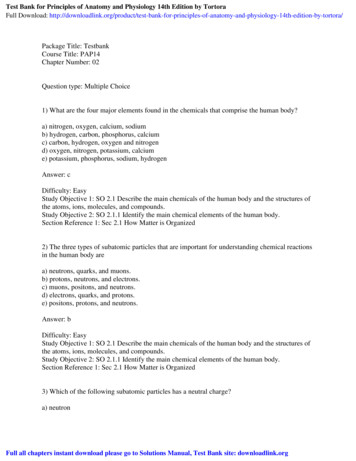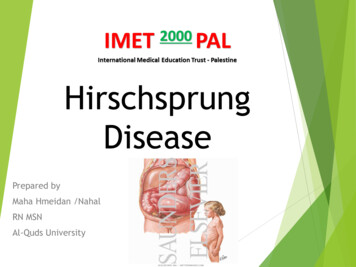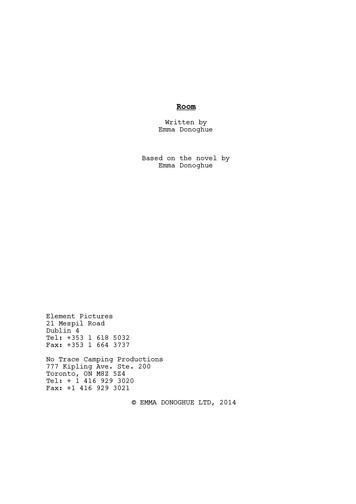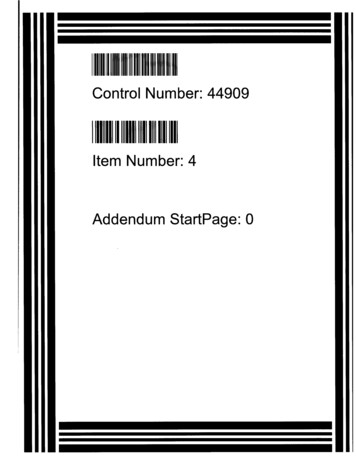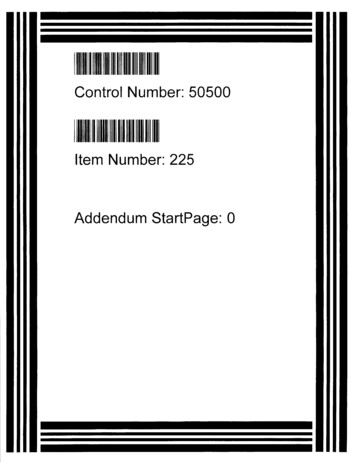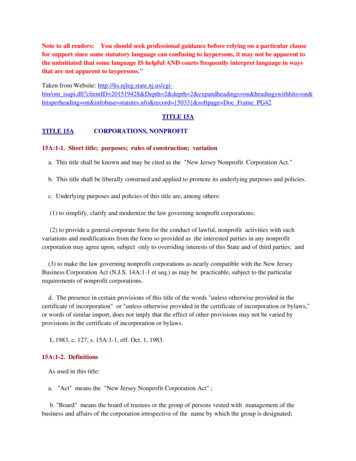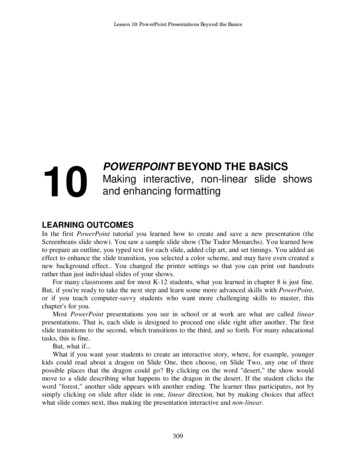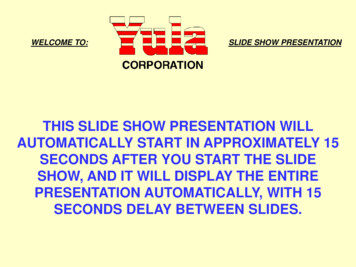
Transcription
Nutrition Care Process Tutorial 2020Module 3: Nutrition Diagnosis - Overview, Terms, Use and PES StatementsSlide NumberTitleScript1Module 3: Nutrition Diagnosis Overview, Terms, Use and PESStatementsWelcome to the Nutrition Care Process Tutorial. This is module 3, NutritionDiagnosis – Overview, Terms, Use and PES Statements. This module is basedon the eNCPT 2019 edition, available on www.ncpro.org.2NCP Tutorial: Module 3 ObjectivesThe objective of module 3 is to understand the purpose and components ofNutrition Diagnosis, including: The process of reaching a nutrition diagnosis,the organization of domains and classes of Nutrition Diagnosis terminology,and the PES Statement.3NCP Step 2: Nutrition DiagnosisNutrition Diagnosis is the second of four steps in the Nutrition Care Process.The purpose of Nutrition Diagnosis is to identify and label existing nutritionproblems that the RDN is responsible for treating.Nutrition problems are identified using assessment evidence, and thenutrition diagnosis is the link between assessment and intervention.4Nutrition Diagnosis ActionsDuring the Nutrition Diagnosis step, RDNs do the following: Identify the nutrition problem Determine the etiology List the corresponding signs and symptomsTo complete these actions, the RDN uses critical thinking skills to: Identify and prioritize problems that can most likely be resolved orimproved by the RDN. They also; Evaluate if the etiology or “root cause” can be addressed with anutrition intervention, and lastly they;
Nutrition Care Process Tutorial 2020Module 3: Nutrition Diagnosis - Overview, Terms, Use and PES Statements Select signs and symptoms from assessment data that will indicate ifa problem is resolved or improved5Nutrition Diagnosis TerminologyNutrition Diagnosis Terminology is categorized into the following 3 Domains:1. Intake (NI)2. Clinical (NC)3. Behavioral-Environmental (NB)“No nutrition diagnosis at this time” may be documented if the assessmentindicates that no nutrition problem exist to justify a nutrition intervention.6Intake (NI)The Intake (NI) domain consists of terms that describe nutrition problemsrelated to intake of energy, nutrients, fluids, and bioactive substancesthrough oral diet or nutrition support.This slide shows an example of the hierarchy and organization for the Oral orNutrition Support Intake class of terms. ‘Inadequate Energy Intake’ is asample nutrition diagnosis that exists in this class. Other classes of nutritiondiagnoses in the intake domain include but are not limited to: Energy Balance (NI-1) Fluid Intake (NI-3) Carbohydrate and Fiber (NI-5.8) Vitamin (NI-5.9)When evidence of a nutrition problem is equal and there is a choice betweenusing nutrition diagnoses from different domains, consider prioritizing theIntake nutrition diagnosis first, since this domain is most specific to the role ofthe RDN.
Nutrition Care Process Tutorial 2020Module 3: Nutrition Diagnosis - Overview, Terms, Use and PES Statements7Clinical (NC)The next domain is Clinical. This domain includes nutrition diagnoses thatcapture nutrition problems related to medical or physical conditions.This slide shows an example of the hierarchy and organization for theFunctional class of terms. ‘Swallowing Difficulty’ is a sample nutritiondiagnosis that exists in the functional class. Other classes of nutritiondiagnoses in the Clinical domain include but are not limited to: Biochemical (NC-2) Weight (NC-3) Malnutrition Disorders (NC-4)8Behavioral-Environmental (NB)The next domain— Behavioral-Environmental (NB)—includes nutritiondiagnoses that describe nutritional problems related to knowledge,attitudes/beliefs, or physical environment.This slide shows an example of the hierarchy and organization for theKnowledge and Belief class of terms. The nutrition diagnosis listed, Food andNutrition Related Knowledge Deficit, is an example of a nutrition diagnosisfrom this domain. Other classes of nutrition diagnosis terms within thebehavioral-environmental domain include: Physical Activity and Function (NB-2) Food Safety and Access (NB-3)9PES StatementsThe Nutrition Diagnosis —or nutrition problem—is communicated as astructured sentence called a PES Statement. The PES statement includesthree distinct parts: Problem (Nutrition Diagnosis Term) Etiology (root cause of the problem)
Nutrition Care Process Tutorial 2020Module 3: Nutrition Diagnosis - Overview, Terms, Use and PES Statements Signs and Symptoms (proof of the problem and evidence fromnutrition assessment data)10PES Statement FormatThe PES statement has a distinct format as shown on this slide:Problem related to Etiology as evidenced by Signs and SymptomsThe Problem (or nutrition diagnosis) must always be a nutrition diagnosisterm.A well written PES statement contains the following characteristics: Clear and concise Specific to the client The problem is accurately related to an etiology, and The signs and symptoms are based on reliable and accurate NutritionAssessment data11Evaluating a PES StatementSpecific questions RDNs should ask when evaluating each section of the PESstatements include:For the problem, or ‘P’ – Can the RDN resolve or improve the client’s nutritiondiagnosis?For the etiology, or ‘E’ – Evaluate what has been used as the etiology. Is thisthe most specific root cause that the RDN can resolve or improve with anutrition intervention?For the signs and symptoms, or ‘S’ – Will measuring the signs and symptomsindicate if the problem is resolved or improved? Are the signs and symptomsspecific?
Nutrition Care Process Tutorial 2020Module 3: Nutrition Diagnosis - Overview, Terms, Use and PES Statements12Examples of Correct PES StatementsThis slide shows an example of a well written PES statement: Notice that the‘P’ portion is a nutrition diagnosis term, ‘Inadequate Energy Intake’ this isfrom the Intake Domain.The etiology, ‘decreased ability to consume sufficient energy secondary tochronic COPD’, is the specific reason why the client’s energy intake isinadequate and the RDN can address this with a nutrition intervention.The signs and symptoms, ‘consuming less than 75% of estimated needs forone month, weight loss of 5% in one month, reported lack of appetite’provide clear, concise, quantifiable evidence that the nutrition problemexists.13Examples of Correct PES StatementsIn this second example of a correctly written PES statement, ‘SwallowingDifficulty’ a nutrition diagnosis term from the clinical domain.The etiology ‘post stroke complications’ is root cause of the Nutritionproblem.The signs and symptoms provide specific quantified evidence from thenutrition assessment that support the existence of the nutrition problem‘Swallowing difficulty”.14Examples of Correct PES StatementsIn this next example of a correct PES statement, the ‘P’ portion is ‘LimitedAccess to Food’, a nutrition diagnosis term from the behavioralenvironmental domain.The ‘E’ portion, ‘lack of financial resources to purchase sufficient quantity ofappropriate healthful foods and lack of knowledge regarding food assistanceresources’ is a specific cause the RDN may not be able to fully resolve, but
Nutrition Care Process Tutorial 2020Module 3: Nutrition Diagnosis - Overview, Terms, Use and PES Statementsthey will be able to lessen the signs and symptoms listed that are evidence ofthe nutrition problem.15Example of an Incorrect PESStatementThis slide reviews an example of an incorrectly written PES statement.Notice that the ‘P’ portion, ‘Excess Carb Intake’, is not a nutrition diagnosisterm. This portion would be correct if it were written as ‘ExcessiveCarbohydrate Intake’, an actual NCP term.A common PES Statement mistake is that a symptom of the nutrition problemis often used for the etiology instead of the root cause of the nutritiondiagnosis.In this example, the elevated A1c can be an indicator of excessivecarbohydrate intake, but it is not the reason, or cause, of the excessiveintake. To correct this PES statement, the knowledge deficit should be used inplace of the A1c value for the etiology, and the A1c should be added to thesigns/symptoms portion of the PES as it provides evidence of the nutritionproblem.16Nutrition Diagnosis Status ValuesRDNS can communicate the status of each nutrition diagnosis using thefollowing labels: New Active Resolved DiscontinuedDefinitions for each of these status value can be found on the eNCPT 36.
Nutrition Care Process Tutorial 2020Module 3: Nutrition Diagnosis - Overview, Terms, Use and PES Statements17Nutrition Diagnosis SummaryIn summary, Nutrition Diagnosis, the second step in the Nutrition CareProcess, is communicated through a PES statement. The Nutrition Diagnosiscan be resolved or improved by a nutrition intervention, which will bediscussed in module 4.18Proceed to Module 4This concludes module 3, Nutrition Diagnosis – Overview, Terms, Use and PESstatements. Please proceed to module 4.
3 NCP Step 2: Nutrition Diagnosis Nutrition Diagnosis is the second of four steps in the Nutrition Care Process. . chronic COPD’, is the specific reason why the client’s energy intake is inadequate and the RDN can address this with a nutrition intervention. The signs and symptoms, ‘consuming less than 75% of estimated needs for one month, weight loss of 5% in one month, reported lack .
